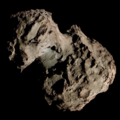 The comet on 12 November 2004, displaying a narrow tail | |
| Discovery [1] | |
|---|---|
| Discovery site | Siding Spring Observatory |
| Discovery date | 10 October 2004 |
| Designations | |
| P/2004 TU12 | |
| Orbital characteristics [2] [3] | |
| Epoch | 5 May 2025 (JD 2460800.5) |
| Observation arc | 35.27 years |
| Earliest precovery date | 23 March 1990 |
| Number of observations | 3,273 |
| Aphelion | 4.894 AU |
| Perihelion | 1.289 AU |
| Semi-major axis | 3.092 AU |
| Eccentricity | 0.58295 |
| Orbital period | 5.33 years |
| Inclination | 27.554° |
| 30.878° | |
| Argument of periapsis | 357.24° |
| Mean anomaly | 291.51° |
| Last perihelion | 7 December 2020 |
| Next perihelion | 17 May 2026 |
| TJupiter | 2.792 |
| Earth MOID | 0.239 AU |
| Jupiter MOID | 0.587 AU |
| Physical characteristics | |
Mean diameter | 14.06±0.96 km [4] |
| 32.864±0.001 hours [5] | |
| 0.022±0.003 [5] | |
| (V–R) = 0.45±0.01 [6] | |
| Comet total magnitude (M1) | 15.2 |
162P/Siding Spring is a Jupiter-family comet with an orbital period of 5.3 years. It was discovered in images obtained on 10 October 2004 as part of the Siding Spring Survey. [1]

